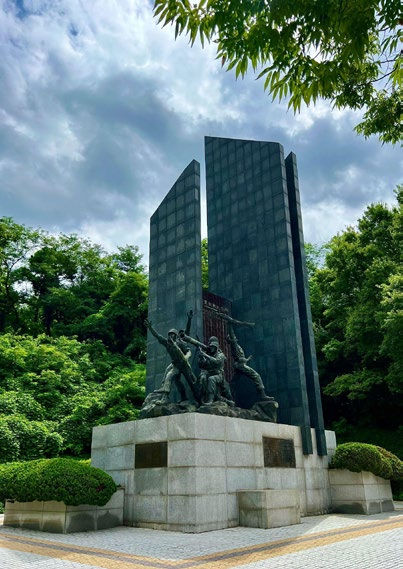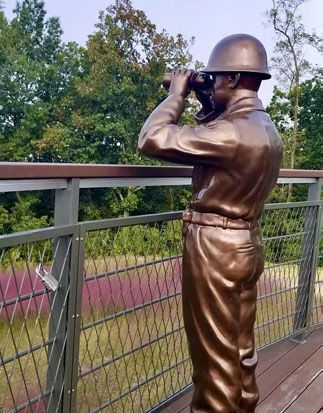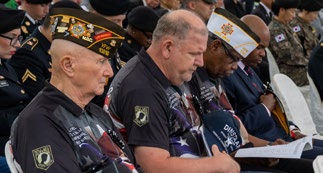75 Years Later: Honoring the UN Forces’ First Battle in Korea at Osan
- Cord A. Scott, Ph.D

- Jul 3
- 6 min read
Updated: Jul 26

The Road to Osan: How the UN Entered the Korean War
By June 28th, 1950, the Korean War was but a few days old, but things were going badly for the ROK forces. North Korean troops were in Uijeongbu and were pushing on Seoul, which would fall by the 30th. At this same time, the UN authorized the first troops to assist South Korean forces, and the US activated elements of the 24th Infantry Division, which were stationed in southern Japan.
Setting the Stage: U.S. Troops Prepare for Battle in Osan
The US contingent south of the 38th parallel had diminished from approximately 25,000 in 1945 to a mere 500 by the late spring of 1950. Simply put, the attack from the north was unexpected. As troops and supplies were gathered, then loaded onto ships bound for Busan, an area that had to be defended was assessed. Finally, Lt. Col Charles B “Brad” Smith of the 21st Regiment was chosen to lead this defense. Troops loaded onto trains at Busan, then went north to Taejon, and finally set up defensive positions in Osan. It was here that the first direct battle between North Korean and US forces occurred in the Korean conflict. This engagement, now recognized as the UN Forces First Battle Korea, marked the beginning of the international effort to resist northern aggression on the peninsula.
UN Forces First Battle Korea: The Clash at Osan on July 5, 1950
On July 5, 1950, at approximately 8 am, the first shots rang out as forward positions of the approximately 540 US troops shot at the North Korean tank column coming down the road from Seoul. This was the North Korean Fourth Division, which was equipped with tanks, artillery, and some air power. The Americans had some artillery in the form of 75mm and 105 mm cannons, but that was all.
The Human Cost: Remembering the Soldiers of Task Force Smith
Despite a valiant defense of the area, by 10 am, the site was overrun, and the US and ROK forces in the area retreated. For the task force, this scattered troops, with 60 killed, 21 wounded severely, and 82 captured. It also started a long series of retreats towards Busan.
Honoring History at Osan Jukmiryeong Peace Park
The site of the battle has been somewhat preserved and now serves as the UN Forces First Battle Memorial Museum. To get to this site, one merely has to take the number 1 train line to the Soma stop, four stops north of Songtan (Osan Air Base).
Exploring the UN Forces First Battle Memorial Museum
The museum itself is free to all and has several different markers in the area. Across the street from the actual museum is a marker to the members of the 24th Infantry Division to commemorate the battle. South of the museum itself is a large marker with large statues of soldiers on it, demonstrating their larger-than-life bravery in the face of such long odds. Inside the two-building museum, some rooms give an overview of the conflict to that point, a 3-d model of the terrain showing how the attack unfolded on July 5, some weapons from that time used in the conflict, and most importantly a room with the names and photos of the men who were part of the battle. This room, in particular, gives the battle a very personal touch.

As one goes out of the first building towards the second, there is a green area with sculptures to commemorate the battle and the sacrifices. The second building goes into further detail on the rush to get men to the location to stop the onslaught of the northern forces. Again, personal stories and photographs are on the walls to show the human cost of the battle.

Finally, as one goes up the hill to a viewing platform, a life-size bronze statue of Lt. Col. Smith is situated at approximately the same area as he coordinated the battle, as well as the battery fire from the artillery units. One can see where the old road from Seoul was located between the hills.
Annual July 5 Commemorations: Keeping the Memory Alive
There is usually a commemoration of the battle on July 5 of each year. Speakers will gather, along with witnesses and veterans of the battle.
Why the Battle of Osan Still Matters 75 Years Later

If one sees a veteran, it would be rare, as many of these men are now in their mid-90s. Given the length of time that has passed, their history needs to be preserved as well.
Honoring Sacrifice Across Korea: More Stories from the 75th Anniversary
As we pause to reflect on the Battle of Osan and the lives lost during those early days of the Korean War, it's important to recognize that this history stretches far beyond one battlefield. Across the peninsula, communities continue to remember and honor the service members who answered the call.
In Canadian Valor: Honoring Canadian Soldiers in the Korean War 75 Years Later, we share how Canadians stood alongside the United Nations forces and continue to be recognized for their bravery and sacrifice in Korea.
For a broader look at this milestone year, The 75th Anniversary of the Korean War offers a historical overview and highlights ongoing remembrance efforts throughout Korea and beyond.
Along the quiet bends of the Nakdong River, memorials stand as silent witnesses to intense battles and heroism. Explore these poignant tributes in Along the Nakdong River: Korean War Memorials in Chilgok-gun County—a region deeply tied to the war’s history and sacrifice.
In The King of Battle: The Legacy of the United States Field Artillery, we explore how artillery units shaped the outcomes of major conflicts and continue to play a vital role in the defense of freedom around the world.
Together, these stories help us see the full picture of remembrance across Korea—reminding us not just of what was lost, but of the enduring gratitude that continues to shape our present.
Exploring More About the Battle of Osan and Its Lasting Legacy
The story of the Battle of Osan is one of bravery, sacrifice, and the sobering realities of war. For those who wish to explore this history more deeply, several trusted resources offer expanded insight into the battle, Task Force Smith, and how the legacy of this first engagement continues to be honored today.
The Osan UN Forces First Battle Memorial Hall The City of Osan’s official memorial website provides an overview of the memorial hall, which honors those who gave their lives during the first U.S. engagement of the Korean War. Visitors can find information about the exhibits, location, and significance of the site.
U.S. Army Center of Military History To gain a broader understanding of the Korean War and its campaigns, the Army’s historical overview offers valuable background on the events that shaped the early days of the conflict, including the challenges faced during the summer of 1950.
The Readiness Challenge of Task Force Smith The National Museum of the United States Army’s article on Task Force Smith and the Problem with Readiness takes a deeper look at what went wrong and why this battle became a pivotal lesson in military preparedness.
75th Anniversary Commemoration The legacy of Task Force Smith continues to be honored. During the 75th anniversary, Soldiers from Eighth Army and the 25th Infantry Division gathered in Osan to commemorate the battle and remember those who made the ultimate sacrifice.
These resources offer an opportunity to reflect, learn, and appreciate the profound legacy of the Battle of Osan—one that still resonates today through the continued efforts to preserve its memory and honor its heroes.
The appearance of U.S. Department of Defense (DoD) visual information does not imply or constitute DoD endorsement.


1 Comment